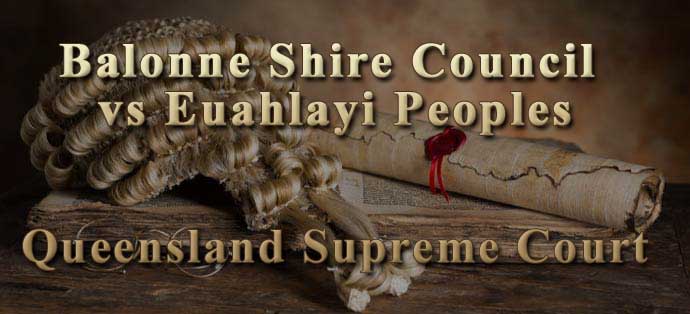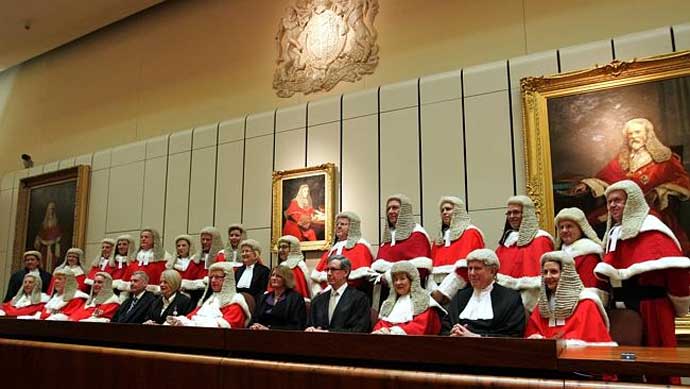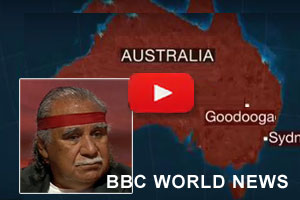Charter of the United Nations does not apply to Australia, claims Qld lawyer in Euahlayi 'rates case'
| 5 May 2014 |

5 May 2014
In another dramatic follow-up to the Euahlayi 'rates dispute', this time in the Queensland Supreme Court between the Balonne Shire Council and the Euahlayi Peoples of far north-western New South Wales and southwest Queensland, the Queensland Minister for Natural Resources and Mines (with responsibility for Lands) presented in writing an admission that there are no cession documents, nor surrender documents as a result of war, relating to the Euahlayi Peoples, neither are there any documents to show that the Euahlayi Peoples' Allodial Title to land was transferred to the Crown's Land tenure system.
Alarmingly, Balonne Shire Council's defence lawyer asserted that the international law of the Charter of the United Nations does not apply to Australia.
In a statement issued from Brisbane today Ghillar Michael Anderson said:
The Euahlayi Peoples' argument focuses primarily on who owns the Allodial title to the land.
I have successfully shifted the burden of proof to the Crown. The Queensland Minister for Natural Resources and Mines (with responsibility for Lands) presented in writing an admission that there are no cession documents, nor surrender documents as a result of war, relating to the Euahlayi Peoples, neither are there any documents to show that the Euahlayi Peoples' Allodial Title to land was transferred to the Crown's Land tenure system.
This reverses the Native Title processes and the onerous burden of proof owners of Country have to go through in the court system. It is a monumental shift in the legal process that all First Nations Peoples could adopt.
The defence may well now rely on the question of jurisdiction. However in the Euahlayi submissions to the Supreme Court of Queensland the question of jurisdiction will be hard fought.
Given that Euahlayi Peoples Republic has made a Unilateral Declaration of Independence, which has now been submitted to the UN Secretary-General, Mr Ban Ki-moon, the question of State jurisdiction and territorial integrity of the Euahlayi is now a paramount legal argument.
What is disturbing is that the Balonne Shire appears to be reliant upon precedents in the criminal jurisdiction to validate the conveyancing of real property. The two do not meet and are very different from each other in law. For example, Balonne Shire is using R v Anning [QCA 2013 263 paras 40 – 53], which is a civil disobedience case, as opposed to the question of the legal transfer of real property by cession or surrender.
Surprisingly counsel for the Balonne Shire Council has also proposed that the force of international law and the Charter of the United Nations is extremely doubtful in relation to its transfer to Australian domestic law.
These arguments will be contested by the Euahlayi People on 20 May 2014 in the Supreme Court of Queensland in Brisbane.

Background:
In a major revelation flowing from a legal challenge by the Euahlayi People, it has come to light that the Commonwealth Government of Australia has been deceiving the United Nations, and the international community in general, by purporting to have committed Australia as a Nation State to the 1945 Charter of the United Nations, without any encumbrances. The Euahlayi People express alarm and concern that a matter of such significance has been ignored by the United Nations.
In the matter of Ngurapmpaa v Balonne Shire Council in Supreme Court of Queensland [1330/14], Balonne Shire Council's defence lawyer asserted that the international law of the Charter of the United Nations does not apply to Australia. The case involves the basis of right of the Balonne Shire Council to charge Euahlayi People land rates on land that has been returned as redress for past dispossession. I have subpoenaed the documents for Balonne Shire Council to prove how Euahlayi Allodial title to land was transferred to the Crown's land tenure system.
On 30 April 2014 Mr M. P.Amerena, of King and Company Solicitors, Counsel for the Balonne Shire Council stated in his outline of argument at paragraph 30:
- In any event, the Charter of the United Nations does not have force of law in Australia; see Bradley v The Commonwealth and Joosse v ASIC. See also Minister for Foreign Affairs v Magno. In short, the content of the Charter has not been carried into effect within Australia by appropriate legislation. The better view is that what is now s.5 of the Charter of the United Nations Act 1945 serves only for the purposes of international law, to ratify Australia's participation in the United Nations.
The Commonwealth of Australia's Charter of the United Nations Act 1945, as amended in 2010, appears to bring the international law into domestic law. Section 5 states clearly:
Part 2—Approval of Charter
5 Approval
The Charter of the United Nations (a copy of which is set out in the Schedule) is approved.
But in the case law that the Balonne Shire relies upon, Bradley v Commonwealth ("Rhodesia Information Centre case") [1973] HCA 34; (1973) 128 CLR 557 (10 September 1973), Chief Justice Barwick along with Justices Gibbs and Stephen stated the rationale for the decision (ratio decidendi) which is binding on lower courts. The Commonwealth Law Report summary states:
Barwick CJ with Gibbs and Stephen JJ held that Section 3 of the Charter of the United Nations Act 1945 did not make the Charter binding on persons within Australia as part of the municipal law and neither the Charter nor the Resolution of the Security Council had been carried into effect by legislation in Australia. Hence they could not be relied upon to justify executive acts or resist an injunction to restrain an excess of executive power.
Alarmingly, this assertion permits a dictatorial tyranny to rule in Australia.
The judgment of Chief Justice Barwick and Justice Gibbs refers to section 3 of the UN Charter when in fact it is now Section 5 which states that the UN Charter is "approved":
The Parliament has passed the Charter of the United Nations Act 1945 (Cth), s. 3 of which provides that "The Charter of the United Nations (a copy of which is set out in the Schedule to this Act) is approved". That provision does not make the Charter itself binding on individuals within Australia as part of the law of the Commonwealth ...
Section 3 of the Charter of the United Nations Act 1945 was no doubt an effective provision for the purposes of international law, but it does not reveal any intention to make the Charter binding upon persons within Australia as part of the municipal law of this country, and it does not have that effect.
This conundrum is further expressed in the Federal Court case Minister for Foreign Affairs v Magno 1992, which focuses on the demountable shed placed by East Timorese on the lawns of the Indonesian Embassy in Canberra after the Dili massacre in 1991. Gerardo Magno challenged the validity of amendment 'SR No. 7' (Statutory Regulation No. 7) to the Diplomatic Privileges and Immunity Regulations purportedly signed by the Governor-General Bill Hayden1 on 15 January 1992.
In this case Justice Gummow compares the binding nature on Australian domestic law of the Vienna Convention on the Law of Treaties as opposed to the UN Charter. Again s. 3 should read s. 5:
- Secondly, not all legislative approval of treaties or other obligations entered into by the Executive renders the treaty binding upon individuals within Australia as part of the law of the Commonwealth, or creates justiciable rights for individuals. An example is s. 3 (sic) of Charter of the United Nations Act 1945. This simply states that the Charter is "approved", something insufficient to render the Charter binding on individuals in Australia: Bradley v The Commonwealth [1973] HCA 34; (1973) 128 CLR 557 at 582, Koowarta supra at 224. See also Dietrich v The Queen supra pp 66-67. The legislation with which this appeal is concerned is not within this class, because s. 7 states that certain provisions of the Convention "have the force of law" in Australia.
We recall UN General Assembly Resolution 56/83 12 December 2001,
- Responsibility of States for internationally wrongful acts
:
Article 12 Existence of a breach of an international obligation
There is a breach of an international obligation by a State when an act of that State is not in conformity with what is required of it by that obligation, regardless of its origin or character.
The United Nations is obligated to ensure that all UN Member States adhere to and respect international law, and in particular meet their obligations arising from the signing and ratification of international treaties.
 Contact: Ghillar Michael Anderson
Contact: Ghillar Michael AndersonHead of State of Euahlayi Peoples Republic
Convenor and Joint Spokesperson of the Sovereign Union
of First Nations and Peoples in Australia www.sovereignunion.mobi
Ph: 0427 292 492, ghillar29@gmail.com,


